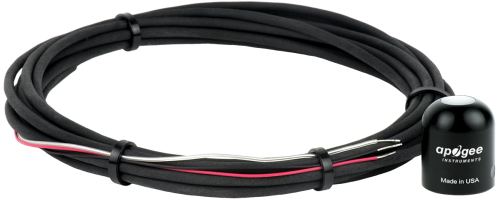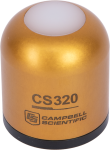This product is not available for new orders. We recommend ordering: CS301.

| Services Available |
|---|
Overview
The CS300, manufactured by Apogee Instruments, measures total sun and sky solar radiation for solar, agricultural, meteorological, and hydrological applications. Its spectral range of 360 to 1120 nanometers encompasses most of the shortwave radiation that reaches the Earth's surface. This pyranometer connects directly to our dataloggers. Its output can be measured by all of our dataloggers.
Read MoreBenefits and Features
- Compatible with most Campbell Scientific data loggers
- Designed for continuous, long-term, unattended operation in adverse conditions
- Measurement waveband of 360 to 1120 nm
- Dome-shaped head prevents water from accumulating on the sensor head
Images




Similar Products
Detailed Description
The CS300 uses a silicon photovoltaic detector mounted in a cosine-corrected head to provide solar radiation measurements for solar, agricultural, meteorological, and hydrological applications. Calibrated against a Kipp & Zonen CM21 thermopile pyranometer, the CS300 accurately measures sun plus sky radiation for the spectral range of 360 to 1120 nm. Sensors calibrated to this spectral range should not be used under vegetation or artificial lights.
The standard output is 0.2 mV per W m-2, which provides a signal of 200 mV in full sunlight (1000 W m-2). All of our dataloggers, including the CR200(X) series, can measure this output.
Compatibility
Note: The following shows notable compatibility information. It is not a comprehensive list of all compatible or incompatible products.
Dataloggers
| Product | Compatible | Note |
|---|---|---|
| 21X (retired) | ||
| CR10 (retired) | ||
| CR1000 (retired) | ||
| CR1000X (retired) | ||
| CR10X (retired) | ||
| CR200X (retired) | ||
| CR206X (retired) | ||
| CR211X (retired) | ||
| CR216X (retired) | ||
| CR23X (retired) | ||
| CR295X (retired) | ||
| CR300 (retired) | ||
| CR3000 (retired) | ||
| CR310 | ||
| CR500 (retired) | ||
| CR5000 (retired) | ||
| CR510 (retired) | ||
| CR6 | ||
| CR800 (retired) | ||
| CR850 (retired) | ||
| CR9000 (retired) | ||
| CR9000X (retired) |
Additional Compatibility Information
Sensor Mounts
Accurate measurements require the sensor to be leveled using a 18356 leveling fixture. This leveling fixture incorporates a bubble level and three adjusting screws. The 18356 mounts to a crossarm or a tripod or tower mast using the CM225 mounting stand. The CS300 should be mounted away from all obstructions and reflective surfaces that might adversely effect the measurement.
Data Logger Considerations
One differential analog input channel per probe is required.
Specifications
| Spectral Range | 360 to 1120 nm (wavelengths where response is 10% of maximum) |
| Measurement Range | 0 to 2000 W/m2 (full sunlight ≈1000 W/m2) |
| Absolute Accuracy | ±5% for daily total radiation |
| Sensitivity | 5 mV/Wm-2 |
| Calibration Factor | 5 W/m2/mV |
| Cosine Correction Error | ±5% at 75° zenith angle; ±2% at 45° zenith angle |
| Temperature Response | 0.04 ± 0.04% per °C |
| Response Time | < 1 ms |
| Long-Term Stability | < 2% per year |
| Operating Temperature Range | -40° to +70°C |
| Relative Humidity Range | 0 to 100% |
| Output Sensitivity | 0.2 mV/W/m2 |
| Diameter | 2.4 cm (0.9 in.) |
| Height | 2.5 cm (1.0 in.) |
| Weight | 65 g (2.3 oz) with 2-m (6.6-ft) lead wire |
Documents
Brochures
Manuals
Frequently Asked Questions
Number of FAQs related to CS300-L: 6
Expand AllCollapse All
-
Compare the sensor against a recently calibrated CS300-L on a clear, sunny day with the sun overhead. Ensure that the sensor being used as a reference is also level.
-
No. It’s not the range that makes a sensor a quantum sensor. It is the type of light filter used with the photocell that only allows specific wavelengths of light in the PAR frequency range to strike the photocell.
-
The leveling base provides physical stability and helps ensure the sensor is leveled correctly. It is not recommended to use the sensor without the base. The sensor mounts to the base with an included bolt. However, a user-supplied plate with a hole drilled in it could be used instead to accept the sensor’s mounting bolt.
Note: Whatever mounting method is used, the sensor has to be levelled to operate correctly.
-
Campbell Scientific does not recommend splicing any cable into the existing cable. Splicing a cable could introduce water and electrical noise into the connection. The sensor can be ordered with longer cable lengths, and 50 m is right on the edge of the recommended length. With a cable this long, Campbell Scientific recommends measuring the sensor differentially using the following wiring conventions:
Wire Color
Data Logger Channel
RED
Diff Channel H
BLACK
Diff Channel L
CLEAR (SHIELD)
AG or Ground Symbol
JUMPER WIRE
Diff Channel L to AG or Ground Symbol
In the data logger program, a differential voltage instruction needs to be used instead of a single-ended voltage instruction.
-
To incorporate a sensor that is compatible with wireless sensor interfaces into a wireless network, a CWS900-series wireless sensor interface is needed, as well as an A205 CWS-to-PC interface to configure it.
Case Studies
Dr. Joan Girona of the Institute of Agroalimentary Research and Technology in Catalonia, Spain, studies......read more


